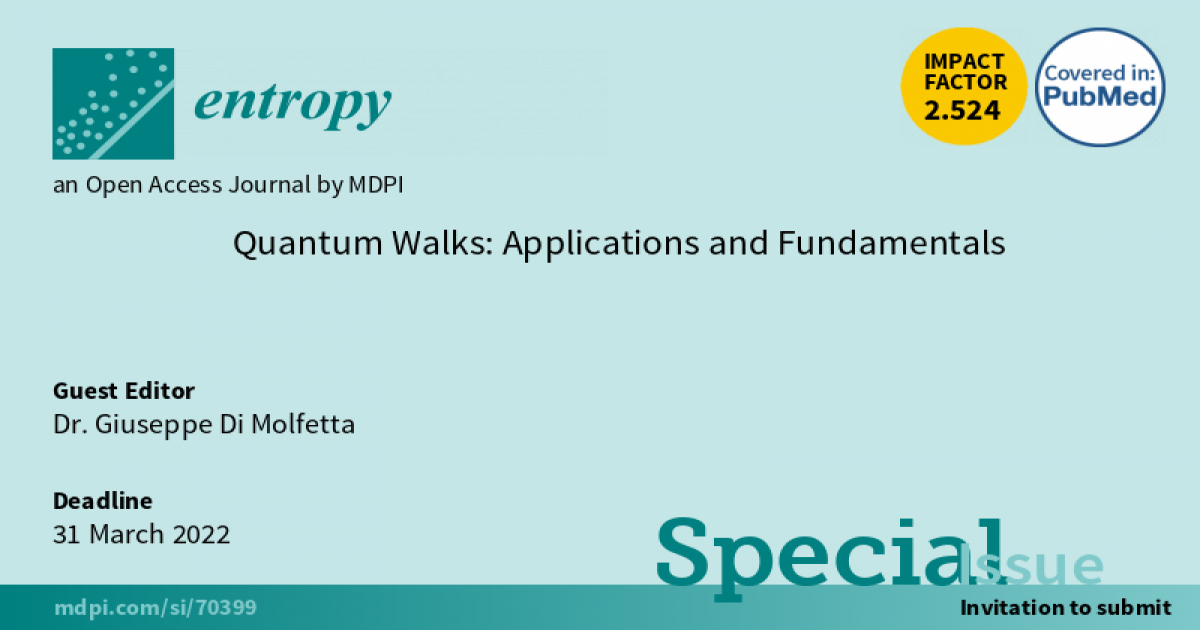Quantum Walks: Applications and Fundamentals
A special issue of Entropy (ISSN 1099-4300). This special issue belongs to the section "Quantum Information".
Deadline for manuscript submissions: closed (31 March 2022) | Viewed by 6726

Special Issue Editor
Special Issue Information
Dear Colleagues,
Quantum walks (QWs), and their generalizations, the multiparticle quantum lattice gas automata (QLGA), and the quantum cellular automata (QCA), underlie simulations of physics, many a search algorithm, and are participants in aspects of quantum machine learning (QML). The emergence of quantum devices presents opportunities to extend the reach of classical computing through quantum algorithms. Often, techniques developed to simulate fundamental physics, among them QW and QCA, find applications in quantum/hybrid algorithms and accelerate optimizations. In the current noisy intermediate-scale quantum (NISQ) regime of quantum devices, competing criteria of noise and decoherence and the availability of limited resources must be considered in simulations, and QWs are no exception. Circuits for QWs will avail quantum error correction (QEC)-based schemes for fault tolerance in the future, when a higher number of qubits, error-corrected, are available.
Considering the recent advances achieved in the field of QW, this Special Issue will collect new ideas and describe promising methods arising from the field of QW-based quantum computation and quantum simulation.
This Special Issue will accept unpublished original papers and comprehensive reviews focused on (but not restricted to) the following research areas, where QW and QCA play a main role:
- QW- or (QCA-) based quantum simulation;
- QW-based quantum algorithmics with and without QEC;
- Fault-tolerant quantum cellular automata;
- QW and their application to quantum machine learning;
- QW and their application to quantum communication and cryptography.
Dr. Giuseppe Di Molfetta
Guest Editor
Manuscript Submission Information
Manuscripts should be submitted online at www.mdpi.com by registering and logging in to this website. Once you are registered, click here to go to the submission form. Manuscripts can be submitted until the deadline. All submissions that pass pre-check are peer-reviewed. Accepted papers will be published continuously in the journal (as soon as accepted) and will be listed together on the special issue website. Research articles, review articles as well as short communications are invited. For planned papers, a title and short abstract (about 100 words) can be sent to the Editorial Office for announcement on this website.
Submitted manuscripts should not have been published previously, nor be under consideration for publication elsewhere (except conference proceedings papers). All manuscripts are thoroughly refereed through a single-blind peer-review process. A guide for authors and other relevant information for submission of manuscripts is available on the Instructions for Authors page. Entropy is an international peer-reviewed open access monthly journal published by MDPI.
Please visit the Instructions for Authors page before submitting a manuscript. The Article Processing Charge (APC) for publication in this open access journal is 2600 CHF (Swiss Francs). Submitted papers should be well formatted and use good English. Authors may use MDPI's English editing service prior to publication or during author revisions.
Keywords
- quantum walks
- quantum cellular automata
- quantum simulation
- quantum algorithmics






